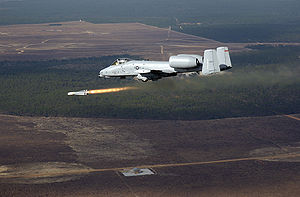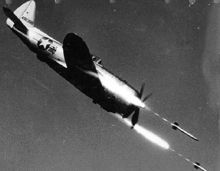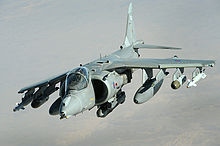- Ground-attack aircraft
-
Ground-attack aircraft An A-10 Thunderbolt II firing an AGM-65 Ground-attack aircraft are military aircraft with primary role of attacking targets on the ground with greater precision than bombers and prepared to face stronger low-level air defense.[1] This class of aircraft is ideal for close air support on the battlefield,[2] but they are also employed in other missions, for example air interdiction[2] or offensive counter air.
A more general category is an attack aircraft which, in addition to ground-attack types, includes aircraft for naval air-to-surface missions.[2] To clarify a common mistake: as opposed to fighter aircraft, attack aircraft are not necessarily intended for air-to-air combat. However, they are often equipped with air-to-air missiles for self-defense.
Until the precision-guided munitions became standard in 1960s, the term "attack aircraft" implied a heavily armored aircraft armed with both bombs and with forward-firing automatic weapon—the former were more powerful, but the latter enabled strafing attacks of much higher precision. Many fighter-bombers of the era fell into this category naturally, if sufficiently armored.
Currently, attack helicopters dominate the field of aircraft types built specifically for an attack role. Few fixed-wing designs are currently employed, as air forces tend to assign the task to the ubiquitous multirole combat aircraft (sometimes described also as strike fighters). Notable exceptions include the American A-10 Thunderbolt II and the Russian Sukhoi Su-25 Frogfoot.
A variety of light attack aircraft exist, usually based on adapted trainers or other light fixed-wing aircraft.
Contents
Definition and designations
United States definition and designations
As with many aircraft classifications, the definition of attack aircraft is somewhat vague and has tended to change over time. Current U.S. military doctrine defines it as an aircraft which most likely performs an attack mission, more than any other kind of mission. Confusingly, attack mission specifically means tactical air-to-ground action — in other words, neither air-to-air action nor strategic bombing is considered an attack mission.[3] In United States Navy vocabulary, the alternative designation for the same activity is a strike mission.[3] Attack missions are principally divided into two categories: air interdiction and close air support.[3]
A key difference between attack aircraft and otherwise similar designs is the expectation that they will receive small arms fire and are generally armored to protect the pilot against this threat. In comparison to fighters, they will usually have less speed, less range, less beyond-visual-range missile ordnance, but more powerful air-to-ground weapons. Attack aircraft are best suited for use on tactical level rather than operational or strategic, which means destroying targets of immediate military value, not the targets that could affect future military potential.
Presently, U.S. attack aircraft are identified by the prefix A-, as in "A-6 Intruder". However, until the end of World War II the A- designation was shared between attack planes and light bombers[4][5] for the Army aircraft (as opposed to B- prefix for medium or heavy bombers). The US Navy used a separate designation system and at the time preferred to call similar aircraft scout bombers (SB) or torpedo bombers (TB or BT).[6]
In the last several decades, the rise of the ubiquitous multi-role fighter has created some confusion about the difference between attack and fighter aircraft. According to the current U.S. designation system, an attack aircraft (A) is designed primarily for air-to-surface[7] missions (also known as "attack missions"), while a fighter category F incorporates not only aircraft designed primarily for air-to-air combat, but additionally[8] multipurpose aircraft designed also for ground-attack missions. Just to mention one example amongst many, the F-111 "Aardvark" is designated F, while having only minimal air-to-air capabilities. The single A-only aircraft in the USAF's current inventory is the A-10 Thunderbolt II.
Other designations
British designations have included FB for fighter-bomber and more recently "G" for "Ground-attack" as in Harrier GR1 (meaning "Ground-attack/Reconnaisance, Mark 1").
The NATO reporting names for Soviet/Russian ground-attack aircraft usually classified them as "F" (fighters) instead of "B" (bombers) — possibly because (since Sukhoi Su-7 Fitter) they were similar in size, range, and weapons to Soviet fighters, or were simply derivatives of such.
History
Germany was the first country to produce dedicated ground-attack aircraft (designated CL-class and J-class). They were put into use in autumn 1917,[9] during World War I. Most notable was the Junkers J.I, which pioneered the idea of an armoured "bathtub", that was both fuselage structure and protection for engine and crew. The British experimented with the Sopwith TF series (termed "trench fighters").
Between the World Wars, the United States Marine Corps Aviation applied close air support tactics in the Banana Wars. Not saying they pioneered dive bombing, marine aviators were the first to include it in their doctrine during United States occupation of Haiti and Nicaragua.[10]
World War II
The attack aircraft as a class was defined by the battlefield support mission,[11] not to say it was not able to attack targets in the rear. Until recently such mission required flying where light anti-aircraft fire is routinely observed, necessarily operating at low altitude to precisely identify targets. Since the times of World War I and into the interbellum, other classes of aircraft, light bombers, medium bombers, dive bombers, reconnaissance, fighters, fighter-bombers, could and did[12] perform air strikes in the battlefield environment. All these types could significantly damage ground targets from a low level flight, either by bombing, machine guns, or both. Separation of the attack aircraft from those was done along two lines. One line was the intended primary use. While, for example, light bomber could be used in a battlefield, it was not primarily planned to, and attack aircraft was. A second, more narrow definition, was survivability guaranteed by armor and construction;[12] what for a bomber could be a very risky mission, nearly a suicide, remained an acceptable threat for a sturdy, armored attack aircraft.
- Dedicated ground-attack aircraft
Some forces had the dedicated "attack" units, primarily trained for the role, and procured dedicated aircraft for them. An example was Junkers J.I deployed during World War I.[13] In the interwar period, USAAF was such a force, and although the aircraft such as Curtiss Shrike were unarmored, they were certainly built with the ground attack task in mind. In the World War II, the most notable of this class was the Soviet Ilyushin Il-2 Shturmovik often nicknamed a "flying tank". Nazi Germany did have a very similar class of Schlacht ("battle") aircraft, namely Henschel Hs 123 and Hs 129.
Before the war, the RAF did not believe in close support of ground forces but that its aircraft should be used to inderdict the enemy before it reached the battlefield.[14]
Other than this, the concept of a ground-attack aircraft was not well-defined and various forces worldwide introduced different, often incomparable, categories of aircraft:- Army Co-operation aircraft
The British concept of a light aircraft mixing all the roles that required extensive communication with land forces: reconnaissance, liaison, artillery spotting, aerial supply, and, last but not least, occasional strikes on the battlefield.[15] The concept was similar to front-line aircraft used in the World War I, which was called the CL class in the German Empire.[13] British experience showed types such as Westland Lysander to be unacceptably vulnerable and it was replaced by faster fighter type for photo-reconnaissance, and light aircraft for artillery spotting.
- Light bomber
The last British specification issued for a light bomber was B.20/40 described as a "Close Army Support Bomber" capable of dive bombing and photo-reconnaissance. The specification was dropped and no aircraft were built.[16]
- Dive bomber
In most forces dive bombers did not equip ground-attack units, but were treated as a separate class. Such was in Nazi Germany, which clearly distinguished the Stuka (Sturzkampf-, "dive bombing") units, equipped with Junkers Ju 87 from Schlacht ("battle") units. Wartime experience showed these types to be unacceptably vulnerable.
- Scout-bomber
The United States Navy used scout-bombers such as the Curtiss SB2C Helldiver.
- Fighter-bomber
Main article: Fighter-bomberAlthough not a synonymous class with ground-attack aircraft, fighter-bombers were usually used for the role, and proved to excel at it, even when they were only lightly armored. The Royal Air Force and United States Army Air Forces chose to make use of obsolescent fighters, which they possessed in fairly large numbers, while more modern fighters would establish air superiority. These included the Hawker Hurricane and Republic P-47 Thunderbolt. Some types were variants of fighters built specifically as such, including several versions of the German Focke-Wulf Fw 190. The British Hawker Typhoon, a fast low level fighter, was used first with bombs then rockets.
Weapons
While machine guns and cannon were sufficient against infantry and light vehicles, for operations against tanks heavier weapons were needed such as the 40 mm Vickers S gun which equipped the Hawker Hurricane to good effect in North Africa Campaign (notably No. 6 Squadron RAF). High explosive rockets were used by British, U.S., Soviet and German aircraft though they were (along with bombs) found to be "barely adequate"[17] because of their inaccuracy. Though unlikely to hit and therefore destroy armoured vehicles, the rockets did have an significant effect on enemy morale; even the prospect of a rocket attack was unnerving[18], and the "taxi rank" patrols of rocket-armed aircraft over the Normandy battlefields disrupted or even paralysed movement of German units.
Post World War II
In the immediate post war era the piston-engined ground-attack aircraft remained useful since all of the early jets lacked endurance due to the fuel consumption rates of the jet engines. The higher powered piston engine types that had been too late for World War II were still capable of holding their own against the jets as they were able to both out accelerate and out manouver the jets. The Royal Navy Hawker Sea Fury fighters and the U.S. Vought F4U Corsair and Douglas A-1 Skyraider were operated during the Korean War while the latter continued to be used throughout the Vietnam War.
Most of the post-World War II era air forces have been reluctant to develop fixed-wing combat aircraft specifically for ground-attack. Although close air support and interdiction remain crucial to the modern battlefield, attack aircraft are less glamorous than fighters, and both pilots and military planners have a certain well-cultivated contempt for 'mud-movers.' More practically, the cost of a specialized ground-attack aircraft is harder to justify as opposed to having multirole combat aircraft.
Under the Key West Agreement which governs the allocation of aircraft between the U.S. Army and the U.S. Air Force, fixed-wing ground-attack aircraft were generally allocated to the Air Force, while attack helicopters were generally allocated to the Army. The Army, wishing to have its own resources to support its troops in combat and faced with a lack of Air Force enthusiasm for the ground-attack role, developed the dedicated attack helicopter for roles such as destroying enemy tanks and supporting troops in combat.
Ground attack has become the domain of converted trainers, like the BAE Hawk or the Aero L-39 Albatros, and many trainers are built with this task in mind, like the CASA 101 or the Aermacchi MB-339.
Recent history
On January 17, 1991, Task Force Normandy began its attack on two Iraqi anti-aircraft missile sites. TF Normandy, under the command of LTC Richard A. "Dick" Cody, consisted of nine AH-64 Apaches, one UH-60 Black Hawk and four Air Force MH-53J Pave Low helicopters. The purpose of this mission was to create a safe corridor through the Iraqi air defense system. The attack was a huge success and cleared the way for the beginning of the Allied bombing campaign.[19]
One concern involving the Apache arose when a unit of these helicopters was very slow to deploy during U.S. military involvement in Kosovo. According to the Army Times,[20] the Army is shifting its doctrine to favour ground-attack aircraft over attack helicopters for deep strike attack missions because ground-attack helicopters have proved to be highly vulnerable to small-arms fire; the U.S. Marine Corps has noted similar problems.[21]
In the late 1960s the United States Air Force requested a dedicated close air support (CAS) plane that became the Fairchild Republic A-10 Thunderbolt II. It eventually became a primarily anti-armor weapon with limited capability in the interdiction and tactical bombing role, and even in the anti-tank role it initially met with mixed feelings. The A-10's performance during Operation Desert Storm negated these criticisms. It remained the only dedicated fixed-wing ground-attack aircraft in U.S. service. Overall U.S. experience in the Gulf War, Kosovo, Afghanistan, and Iraq War has resulted in renewed interest in such aircraft. Officially, the U.S. Air Force planned to replace the A-10, with its new "Joint Strike Fighter", the F-35 Lightning II. Facing political concerns that the new fighters were not designed for the ground-attack role that had proven particularly useful in Iraq[22] and Afghanistan,[23][24] a plan to decommission the A-10 has been replaced with a plan to upgrade the existing aircraft with improved electronics,[25] extending the service life of the planes until as late as 2028. The U.S. Air Force has not commissioned any new designs for this role (in part, out of concern for the F-35 program). Nevertheless, the current U.S. doctrine emphasizes the use of United States Army helicopters for close air support and anti-tank missions.
The Soviets' similar Sukhoi Su-25 (Frogfoot) found greater success in the flying artillery role, although it, too, shifted[citation needed] to anti-armor use in later versions and has largely been phased out[citation needed] in favour of fast-moving fighter-bomber versions of the MiG-29 and Su-27.
The UK is replacing its current ground-attack aircraft with the F-35 (replacing the Harriers) and the Eurofighter Typhoon (Tornado IDS).
The other major complication to plans of military forces to purchase new ground-attack aircraft is uncertainty over the degree to which manned fixed wing aircraft may be replaced by unmanned combat drones in this role, a possibility illustrated by the armed Predator drone, which has been used in this capacity.
See also
- Air-to-ground weaponry
- Close air support
- Air interdiction
- Gunship
- Multirole combat aircraft
- Pace-Finletter MOU 1952
References
- ^ Office Of Air Force History Washingtondc, Daniel R Mortensen. A Pattern for Joint Operations: World War II Close Air Support, North Africa. pp. 24–25. ISBN 9781428915640. http://books.google.com/books?id=PEd4-eIdrPQC&lpg=PA25&dq=%22attack%20aircraft%22%20%22light%20bomber%22%20low&pg=PA25#v=onepage&q&f=false.
- ^ a b c Gunston, Bill (2009-07-31). The Cambridge aerospace dictionary. pp. 73. ISBN 9780521191654. http://books.google.com/books?id=WaBLPgAACAAJ.
- ^ a b c Lane Pierrot; Jo Ann Vines (1997). A look at tomorrow's tactical air forces. DIANE Publishing. p. 4. ISBN 0788142984. http://books.google.com/books?id=mOAKC6jQdy0C&lpg=PR12&dq=%22attack%20aircraft%22%20%22strike%20fighter%22%20types&pg=PA4#v=onepage&q=%22attack%20aircraft%22%20%22strike%20fighter%22%20types&f=false. Retrieved 29 January 2011.
- ^ E. R. Johnson (2008-08). American Attack Aircraft Since 1926. p. 413. ISBN 9780786434640. http://books.google.com/books?id=GmFhOCYckfQC&lpg=PA437&dq=%22attack%20aircraft%22%20%22ground%20attack%22%20naval&pg=PA413#v=onepage&q=%22attack%20aircraft%22%20%22ground%20attack%22%20naval&f=false. Retrieved 21 January 2011.
- ^ Merriman, Ray (2000). U.S. warplanes of World War II, volume 1. Bennington, VT: Merriam Press. p. 3. ISBN 9781576381670. http://books.google.com/books?id=R7GjzzNMpu4C&lpg=PA3&dq=designation%20%22A-%22%20%22B-%22%20%22C-%22%20%22P-%22%20aircraft&pg=PA3#v=onepage&q=designation%20%22A-%22%20%22B-%22%20%22C-%22%20%22P-%22%20aircraft&f=false. Retrieved 21 January 2011. ""A: Light Bombing [...] B: Medium and Heavy Bombing""
- ^ For example Douglas SBD Dauntless scout bomber, was designated A-24 when used by the USAAF. It was not until 1946 when US Navy started using "attack" (A) designation, when it renamed BT2D Skyraider and BTM Mauler to, respectively, AD Skyraider and AM Mauler. See http://www.driko.org/usdes.html.
- ^ Designating and Naming Defense Military Aerospace Vehicles. United States Department of the Air Force. 14 April 2005. http://www.af.mil/shared/media/epubs/AFI16-401%28I%29.pdf. Retrieved 29 January 2011. "Attack: Aircraft designed to find, attack, and destroy land or sea targets."
- ^ 16-401(I), pp. 17, "F - Fighter Aircraft designed to intercept and destroy other aircraft or missiles. Includes multipurpose aircraft also designed for ground support missions such as interdiction and close air support."
- ^ Owen Gordon Thetford, E. J. Riding, ed (1954). Aircraft of the 1914-1918 War. p. 56. "Halberstadt CL.II appearance at the Western Front"
- ^ Corum, James S; Wray R Johnson (2003). Airpower in Small Wars — Fighting Insurgents and Terrorists. Lawrence, Kansas: University Press of Kansas. pp. 23–40. ISBN 0700612408.
- ^ Hallion, Richard (2010-10-28). Strike from the Sky: The History of Battlefield Air Attack, 1910-1945. pp. 3–6. ISBN 9780817356576. http://books.google.com/books?id=ZAdtAIMTReEC&lpg=PA17&dq=ground%20attack%20aircraft%20armored&pg=PA5#v=onepage&q&f=false. As a side note, battlefield support is generally divided into close air support and battlefield air interdiction, the first requiring strict and the latter only general cooperation with friendly surface forces.
- ^ a b Franklin Cooling, B; Office Of Air Force History, United States. Air Force (1990). Case studies in the development of close air support. pp. 101,123. ISBN 9780912799643. http://books.google.com/books?id=_mIq1PP0nCEC&lpg=PA491&pg=PA123#v=onepage&q&f=false. For example, during Operation Barbarossa, in the fall of 1941, bulk of German air power was used for close (battlefield) air support, including dedicated fighters and bombers such as He 111.
- ^ a b Hallion, p. 16-22, 77.
- ^ Buttler. British Secret Projects Fighters and bombers 1935-1950 p.65
- ^ Cooling, pp. 1, 158, 244, 263. Hallion, p. 152. Gunston, 2009, p. 61.
- ^ Buttler p67
- ^ Ian Gooderson (1998). Air power at the battlefront: allied close air support in Europe, 1943-45. Routledge. pp. 121. ISBN 9780714646800. http://books.google.com/books?id=rZmMDolRSrsC&pg=PA74&dq=aircraft+strafing+tank+cannon#v=onepage&q=aircraft%20strafing%20tank%20cannon&f=false.
- ^ Shores, Christopher and Thomas, Chris. Second Tactical Air Force Volume Two. Breakout to Bodenplatte July 1944 to January 1945. Hersham, Surrey, UK: Ian Allan Publishing Ltd, 2005. ISBN 1-903223-41-5, pages 245-250
- ^ From Hot Air to Hellfire, James W. Bradin, ISBN 0891415114
- ^ "TRADOC Cuts Apaches’ Role in Deep Attack". Murdoc Online. 1 May 2006. http://www.murdoconline.net/archives/003682.html#more.
- ^ Trimble, Stephen (30 July 2003). "General: Deep-Strike, Urban Tactics For Attack Helicopters May Need Review". Aviation Week. http://www.aviationnow.com/avnow/news/channel_aerospacedaily_story.jsp?id=news/urb07303.xml.
- ^ "CENTAF Releases Airpower Summary Report." U.S. Air Force, 6 April 2006.
- ^ "Combat Operations in Afghanistan." strategypage.com, 2 May 2006.
- ^ Gates, Andrew (2004-08-19). "A-10s Rescue Ambushed Ground Forces". 455th Expeditionary Operations Group Public Affairs. United States Air Force. http://www.af.mil/news/story.asp?storyID=123008450.
- ^ "A-10 Thunderbolt (Warthog) Ground Attack Aircraft, USA." Air Force Technology.
Military aircraft types by roles Military aircraft roles AEW · Bomber · EW · Fighter · Ground-attack · Maritime patrol · Multi-role · Reconnaissance · Surveillance · Tanker · Trainer · Transport
Military aircraft types Military balloon · Military glider · Military helicopter · Missile · UAV
Categories:- Attack aircraft
Wikimedia Foundation. 2010.




